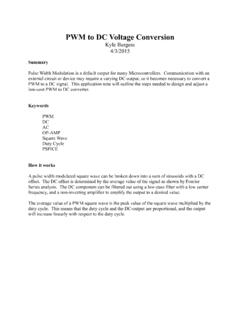Using Pwm
Found 9 free book(s)Pulse Width Modulation Using an Arduino
www.egr.msu.eduPulse Width Modulation Using an Arduino Travis Meade 11/14/2014 Abstract Pulse Width Modulation is a process that is used in many applications. One of the easiest ways to implement this is by using an Arduino. The Arduino can do this in a number of ways. This application note will look at what Pulse Width Modulation is and will also explain how to
PWM Techniques: A Pure Sine Wave Inverter
web.wpi.eduApr 27, 2011 · load using an H-bridge. If this voltage needs to be boosted from the DC source, it can be accomplished either before the AC stage by using a DC-DC boost converter, or after the AC stage by using a boost transformer. The inverted signal itself is composed of a pulse-width-modulated (PWM) signal which encodes a sine wave.
PWM Spindle Control using Mach3 - dave.ogormanfamily.com
dave.ogormanfamily.comPWM Spindle Control using Mach3 Introduction This document outlines my method of controlling spindle speed on various machines. I wanted to pass on to others the experience I gained when I designed and manufactured my cnc lathe. Hopefully this dissertation will make it easier for others.
H-bridge motor controller design using Nexperia discrete ...
assets.nexperia.comH-bridge motor controller design using Nexperia discrete semiconductors and logic ICs 2. Block diagram and system functionality Over-current Detection a a a - 0 3 0 9 6 9 Clock PWM Driving Circuitry H-bridge Motor Power Supply Fig. 2. H-bridge motor controller block diagram 2.1. Subsystems overview 1. Power Supply • Accepts 12 V to 48 V DC input
Adafruit PCA9685 16-Channel Servo Driver
cdn-learn.adafruit.comNov 15, 2021 · Using the Adafruit Library Since the PWM Servo Driver is controlled over I2C, its super easy to use with any microcontroller or microcomputer. In this demo we'll show using it with the Arduino IDE but the C++ code can be ported easily Install Adafruit PCA9685 library To begin reading sensor data, you will need to install the Adafruit_PWMServo ...
Pulse Width Modulated (PWM) Drives - Rockwell …
literature.rockwellautomation.comPulse Width Modulated (PWM) Performance Comparison The graph below shows a drive using Force Technology operating with and without an encoder, and a volts/hertz drive. Notice that there is very little difference in operation with or without an …
PWM generation on STM32 Microcontrollers using HAL
simonmartin.chperiod duration of the PWM. Modify this number to 4095, if you want a 12 Bit PWM. Another thing that happens here, is the initialisation of the PWM on line 180. We’ll get to that later. On line 187 is the second thing you should note, the pulse duration. Modify …
PWM to DC Voltage Conversion - Michigan State University
www.egr.msu.eduPWM to DC Voltage Conversion Kyle Burgess 4/3/2015 Summary Pulse Width Modulation is a default output for many Microcontrollers. Communication with an external circuit or device may require a varying DC output, so it becomes necessary to convert a PWM to a DC signal. This application note will outline the steps needed to design and adjust a
EK-Quantum Reflection PC-O11D XL D5 PWM D-RGB
www.ekwb.comThe EK-D5 PWM pump has two connectors. 1. 4-pin Molex: It must be connected directly to your PSU at all times as it is used to power the pump. 2. 4-pin PWM fan: It can be connected to your motherboard’s CPU_ Fan or designated water pump header. It can also be connected to a controller. This cable is used to control and report








